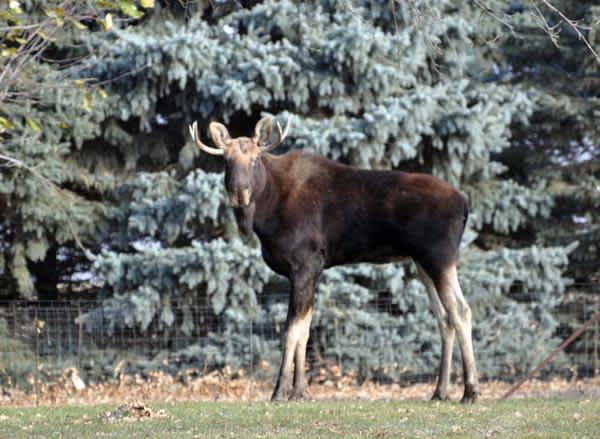Minnesota’s Famous Wandering Moose Was Killed by Brain Worms
OutdoorHub Reporters 02.06.15

Last Friday the Minnesota Department of Natural Resources (DNR) confirmed that the cause of death for a wandering moose in Sleepy Eye, nicknamed “Bullwinkle” by some residents, was a brain worm infection.
The young bull had been first found in the area last November, which was unusual as moose very rarely migrate so far south from their territories in northeastern Minnesota. Fond of eating discarded apples and relaxing in residents’ backyards, the mild-mannered moose quickly became a hit with the people of Sleepy Eye.
“He had become a local favorite,” DNR biologist Michelle Carstensen told the Minneapolis Star Tribune. “They had been watching him for a while and one family put him on their Christmas card.”
Unfortunately for the moose, not all was well. Although biologists at first determined that the young bull appeared to be healthy, it now seems that there was a darker reason for Bullwinkle’s trip to southern Minnesota. University of Minnesota’s Veterinary Diagnostics Lab traced the bull’s death late last year to parasitic brain worms. Also known as “moose sickness,” brain worms can infect deer, moose, elk, and domestic livestock. The parasite is often fatal—except in whitetail deer—and can cause strange behavior in its hosts.
“Did it come down because of brain worms? Probably,” DNR wildlife researcher Lou Cornicelli told the Mankato Free Press.
Brain worms are just one of several issues troubling the state’s moose population, which is plummeting. From 2006 to 2012, state officials say moose numbers have dropped by nearly half, and the causes of mortality are still unclear. A recent census found that the number of moose in northeastern Minnesota, where bullwinkle is believed to have traveled from, is down to about 4,000 individuals. Experts say there are a number of factors behind this change, including an unexpected impact from the state’s wolf population. A recent mortality study by the DNR found that 17 of the 31 moose collared by the agency eventually fell prey to wolves.
“Wolf predation is probably a little higher than we expected,” said DNR researcher Glenn DelGiudice last November. “But we knew it would be a main source.”
Moose mortality research is ongoing and will also look into other factors such as habitat loss and climate change. Somewhat surprisingly, officials say moose numbers received a slight bump last year, although it is too soon to discern whether the population is stabilizing.

